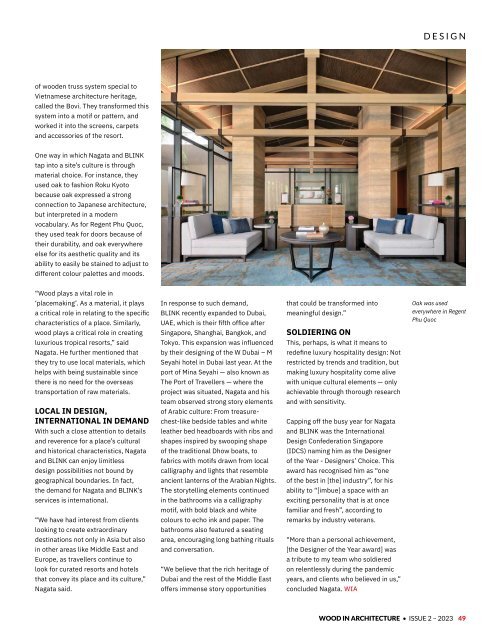WIA_ISSUE2_2023
You also want an ePaper? Increase the reach of your titles
YUMPU automatically turns print PDFs into web optimized ePapers that Google loves.
DESIGN<br />
of wooden truss system special to<br />
Vietnamese architecture heritage,<br />
called the Bovi. They transformed this<br />
system into a motif or pattern, and<br />
worked it into the screens, carpets<br />
and accessories of the resort.<br />
One way in which Nagata and BLINK<br />
tap into a site’s culture is through<br />
material choice. For instance, they<br />
used oak to fashion Roku Kyoto<br />
because oak expressed a strong<br />
connection to Japanese architecture,<br />
but interpreted in a modern<br />
vocabulary. As for Regent Phu Quoc,<br />
they used teak for doors because of<br />
their durability, and oak everywhere<br />
else for its aesthetic quality and its<br />
ability to easily be stained to adjust to<br />
different colour palettes and moods.<br />
“Wood plays a vital role in<br />
‘placemaking’. As a material, it plays<br />
a critical role in relating to the specific<br />
characteristics of a place. Similarly,<br />
wood plays a critical role in creating<br />
luxurious tropical resorts,” said<br />
Nagata. He further mentioned that<br />
they try to use local materials, which<br />
helps with being sustainable since<br />
there is no need for the overseas<br />
transportation of raw materials.<br />
LOCAL IN DESIGN,<br />
INTERNATIONAL IN DEMAND<br />
With such a close attention to details<br />
and reverence for a place’s cultural<br />
and historical characteristics, Nagata<br />
and BLINK can enjoy limitless<br />
design possibilities not bound by<br />
geographical boundaries. In fact,<br />
the demand for Nagata and BLINK’s<br />
services is international.<br />
“We have had interest from clients<br />
looking to create extraordinary<br />
destinations not only in Asia but also<br />
in other areas like Middle East and<br />
Europe, as travellers continue to<br />
look for curated resorts and hotels<br />
that convey its place and its culture,”<br />
Nagata said.<br />
In response to such demand,<br />
BLINK recently expanded to Dubai,<br />
UAE, which is their fifth office after<br />
Singapore, Shanghai, Bangkok, and<br />
Tokyo. This expansion was influenced<br />
by their designing of the W Dubai – M<br />
Seyahi hotel in Dubai last year. At the<br />
port of Mina Seyahi — also known as<br />
The Port of Travellers — where the<br />
project was situated, Nagata and his<br />
team observed strong story elements<br />
of Arabic culture: From treasurechest-like<br />
bedside tables and white<br />
leather bed headboards with ribs and<br />
shapes inspired by swooping shape<br />
of the traditional Dhow boats, to<br />
fabrics with motifs drawn from local<br />
calligraphy and lights that resemble<br />
ancient lanterns of the Arabian Nights.<br />
The storytelling elements continued<br />
in the bathrooms via a calligraphy<br />
motif, with bold black and white<br />
colours to echo ink and paper. The<br />
bathrooms also featured a seating<br />
area, encouraging long bathing rituals<br />
and conversation.<br />
“We believe that the rich heritage of<br />
Dubai and the rest of the Middle East<br />
offers immense story opportunities<br />
that could be transformed into<br />
meaningful design.”<br />
SOLDIERING ON<br />
This, perhaps, is what it means to<br />
redefine luxury hospitality design: Not<br />
restricted by trends and tradition, but<br />
making luxury hospitality come alive<br />
with unique cultural elements — only<br />
achievable through thorough research<br />
and with sensitivity.<br />
Capping off the busy year for Nagata<br />
and BLINK was the International<br />
Design Confederation Singapore<br />
(IDCS) naming him as the Designer<br />
of the Year - Designers’ Choice. This<br />
award has recognised him as “one<br />
of the best in [the] industry”, for his<br />
ability to “[imbue] a space with an<br />
exciting personality that is at once<br />
familiar and fresh”, according to<br />
remarks by industry veterans.<br />
“More than a personal achievement,<br />
[the Designer of the Year award] was<br />
a tribute to my team who soldiered<br />
on relentlessly during the pandemic<br />
years, and clients who believed in us,”<br />
concluded Nagata. <strong>WIA</strong><br />
Oak was used<br />
everywhere in Regent<br />
Phu Quoc<br />
WOOD IN ARCHITECTURE • ISSUE 2 – <strong>2023</strong> 49

















